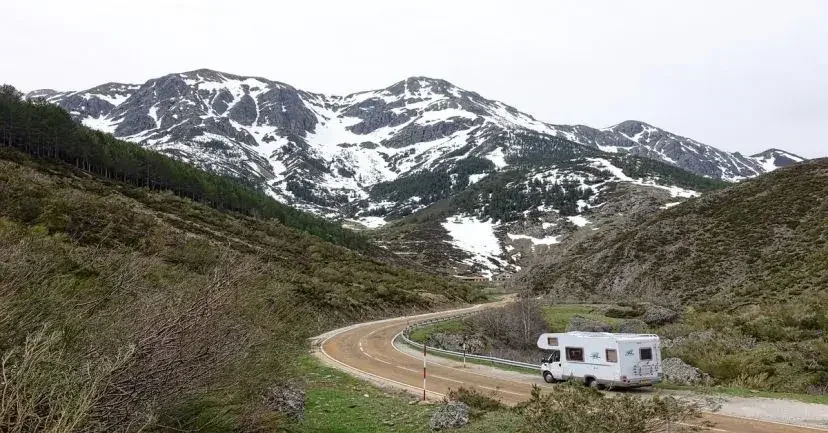Even before the COVID-19 pandemic changed the world as we once knew it, more people were choosing a nomadic lifestyle than ever before. With decent internet and cellular coverage pretty much everywhere you go, the trend moved out of its once-quirky niche and planted itself firmly on the list of viable options for anybody who was looking to live differently.
Even with all the creature comforts, living a nomadic lifestyle and being on the road 24/7 aren't for everyone. You have to have a bit of an adventurous streak and a lot of ingenuity to make it work. Fortunately, we've now got plenty of experiences to draw from those who know.

Nomadic lifestyle—when home is where you are
First things first, though. If you're going to be a nomad, you need to settle on your abode. The nomad of today isn't out wandering the badlands and living off the land. They live in RVs, converted vans, and tiny houses on wheels, and they know a thing or two about living the nomadic dream.
According to some estimates, at least one million Americans live in RVs. They come from all corners of the industry—some are traveling nurses, others are journeymen/women, retirees, digital nomads, or just folks with insatiable wanderlust.
And business is booming. Despite showroom shutdowns forced by COVID-19 restrictions, RV sales exceeded all previous records in 2020, increasing more than 20 percent from a year earlier. And the buyer demographics tell their own story, as it's a market no longer dominated by retirees. Young millennial couples and others in the 35-55 age group have usurped the space previously occupied by folks over 60.
The traditional RV for a nomadic lifestyle
Back in the day, people would pack up their families in the RV and take extended vacations. To make it work, they needed kitchens, sleeping space, tables, storage, and bathrooms. Though the average nomad needs these things too, they usually don't need to accommodate the whole family, kids, and all.
Today, the trend is toward the compact and connected. Instead of substantially changing floorplans, most companies offer optional upgrades to suit, such as long-range Wi-Fi routers, ingenious storage solutions, and mobile office features.
Most manufacturers see this as a growing segment. On the plus side, life in an RV is pretty sweet—you really don't have to compromise space or amenities, and it can be customized to suit your needs. On the downside, they're expensive, both to purchase and maintain, so they might not be the best choice if you're trying to live frugally. You might get lucky and buy a used RV for $10,000, but a top-of-the-line vehicle runs $100,000 and up. Trailers are a little more economical, but depending on the features and amenities you want, they could still run anywhere from $10,000 and up.
Converted vans for nomads
Properly outfitted, converted vans and RVs make it easy to live, work, and play on your own terms. However, not everyone can afford a fully loaded RV. Companies like Dave and Matt Vans found a niche specializing in van conversions for the Work From Anywhere (WFA) crowd. They start with a bare-bones RAM Promaster to build out your ride with customized interiors designed for your specific needs. They even offer to finance, making it even easier to take that leap.
Of course, there's only so much space in any van. Living and working out of a van would be most suitable for singles, unless you and your squeeze get along really well. Plus, you'll need to figure out your shower situation—outdoor camp showers are cool in southern climes, but you'll likely be using motels otherwise, so it's an extra expense you'll need to consider.
The average cost of a fully converted and customized van is about $60,000. On the plus side, it's a self-contained vehicle you can drive and live in. On the downside, you probably will need to borrow a shower now and then, and if you're traveling with others, it might get a little cramped.
Tiny homes on wheels
Tiny houses have taken the world by storm. Like a camping trailer or fifth wheel, you'd need a large vehicle to tow it, but once you park it, you've got all the amenities of a home without the price tag. And when the weather gets nasty, or you grow weary of the view, you can hitch it up and chase the sun.
Tiny homes only look small from the outside—you'd be surprised at the innovative designs out there. Essentially, it's a complete house in miniature, with most clocking in at about 400 square feet. But unlike its more mobile counterparts, it takes a little bit of planning and elbow grease to make it work. For example, you'd need to be able to park it for extended periods, and depending on its size, you might not be able to stay in RV parks either.
That said, there are so many people who've embraced the nomadic tiny house movement. Many are solar-powered, and others run on propane, but there are plenty of options depending on your fuel preferences. Tiny homes can also be safely outfitted with wood or pellet stoves to keep the space cozy and warm in the colder months.
So, you might say that tiny homes are a little bit better suited to nomads who don't necessarily want to do a lot of moving around. Of course, changing the scenery isn't impossible, but the house itself is a bit more unwieldy than your average RV. On the plus side, it's more spacious and versatile. Cost-wise, you can buy or build a tricked-out tiny home for an average of $23,000, a fair sight less than your typical RV or van conversion. Keep in mind, though, that you'll need a reliable, good-sized vehicle to haul it, so that's an additional expense.
Hotel or motel time
Of course, not every nomad needs to live in a mobile home. Many prefer to motel-hop or camp out old-school at campgrounds along the way. Fortunately, there are plenty of tools and solutions available to ensure you've always got an internet connection and that your postal mail ends up where it's supposed to be.
Connectivity and postal mail are two of the most vital issues for any nomad today. Without the internet, you can't work, and without an address, you're not a business.
On the internet side, investing in a Skyroam Solis mobile hotspot keeps you connected from wherever you are.
As for postal mail, a personal virtual mailbox from LegalZoom, is a must-have. Simply choose your address and set up your account. When mail arrives at our processing facility, our trained technicians open, scan, and send you your correspondence as a fully searchable PDF. Sync your account with cloud services like Box.com, Dropbox, or G-Suite. We'll even deposit incoming checks if you need us to—cash flow assured, problem solved!
Is it time to leap into full-time nomadic living? If so, you're one of more than one million Americans who are making it one of the fastest-growing trends of the modern age. But before you hit the road, make sure you've got your business covered with a virtual mailbox. Ready to start receiving your mail from anywhere?

